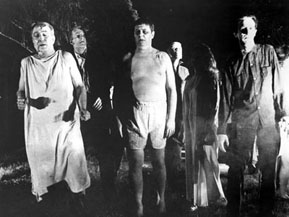Classic Movie Review: Night of the Living Dead
By Josh Spiegel
October 16, 2009
BoxOfficeProphets.com

It's been more than 40 years since this low-budget film from famed director George A. Romero came out, letting loose zombies onto the big screen. Earlier this month, Zombieland, a horror comedy featuring a few lone humans against an apocalypse of the dead-eyed ghouls, hit the top of the box office, and is looking like a true sleeper hit. That movie was made for just about $25 million; Night of the Living Dead was made for just over $100,000. Things, suffice to say, have changed quite a lot. Interestingly enough, one of the biggest problems I had to get over with Night of the Living Dead is the low, low, low budget. Whereas a movie like Zombieland impresses in part because it feels like it had to have cost twice its budget, a movie like Night of the Living Dead looks like...well, every dollar is on the screen.
The plot is pretty much the same as Zombieland or any other zombie movie: zombies have overrun society, and only a few humans are surviving, trying to stave off complete apocalypse. Unlike Zombieland, there's no humor. Or tension. Yes, this will be something of a negative review, and one of something of a classic. At the very least, there wouldn't be an ...Of the Dead series of films without this one. It seems that Dawn of the Dead, the 1978 sequel that was remade in 2004, is considered the best in the series, but it's probably wisest to go back to the beginning and see where things began. Yes, even though I somewhat regret it, it's important to find the roots of something that's gone beyond being a cult fad into a more mainstream idea.
And yet...here's what's interesting: it took a full decade for a sequel to Night of the Living Dead to come out, despite it being a huge success, considering its small budget. In that time, I would imagine that Romero and his cast and crew worked out things like characters and action and dialogue. There's not much of any of that in the original zombie movie, though, aside from its chilling opening scene. The set-up is deceptively simple: a brother and sister, Johnny and Barbara, are headed to their father's grave to place a cross on it. Once they get there, Johnny taunts his sister about her understandable fears of being in a graveyard, saying, "They're coming to get you, Barbara!" And then they see a man walking toward them. And the man tries to kill both of them, succeeding in offing Johnny.
Barbara runs away and hides in a farmhouse, soon joined by Ben, who's by himself and decides to also use the farmhouse as refuge from the onslaught. Then, 20 minutes later, once Ben has used every piece of wood in the tri-state area to board up the farmhouse, they discover that they are not alone in the house. No. Seriously. It takes nearly half of the film's 100-minute running time for Ben and Barbara, who remains appropriately catatonic after her brother's death, to realize that anyone else is alive. And the rest of the time they spend together is putting wood up on the house. Of course, during this section of the film, Ben listens to a radio station that should have been called KEXP, the Exposition Station.
All the station does is tell us that, yes, there are zombies. Yes, they are all over the globe. Yes, there are posses of survivors going around and killing off any and all suspicious-looking characters. And that's about it. The first half of the film tapers off immediately after the opening scene and doesn't pick up any kind of steam until Ben and Barbara are introduced to the other survivors, who aren't exactly an exciting bunch, but they do talk and do more than put wood up. There's a pair of young lovers, and two parents whose daughter has recently been bitten by one of the roving zombies and is slowly turning into one. This kind of dark tragedy should have had a more haunting, poetic edge to it, but since the girl only makes any dent on the story is when...well, you know, there's no excitement.
That's what surprised me most about Night of the Living Dead. A complete lack of excitement. I appreciate that zombie movies aren't usually meant to be a lot of fun, but there is usually some visceral element to be had in watching a bunch of helpless people run for their lives from stumbling, shambling flesh-eaters. So why the hell is this movie so slow, so boring? Moreover, why don't the zombies, you know, attack ever? There's the attack at the beginning and a surprising lack of scares in the middle of the film. Once the other survivors are unearthed, there's a lot of talk about what to do, but it's just talk. I'm not usually so gung-ho, but I was actively hoping for someone to pick up a shotgun or pick up a block of wood and knock some heads.
The final half-hour of the movie is far more action-packed, but by this point, it's hard to care if any of the survivors live, or if the zombies are eradicated by the posses, who are always hinted at instead of shown until the very end. I understand, of course, the limitations of having only $114,000 at your disposal, but whatever tension and horror there is in the other ...Of the Dead films, it's not in Night of the Living Dead, a movie with loads of potential that only paid off in the sequels, rip-offs, and homages.